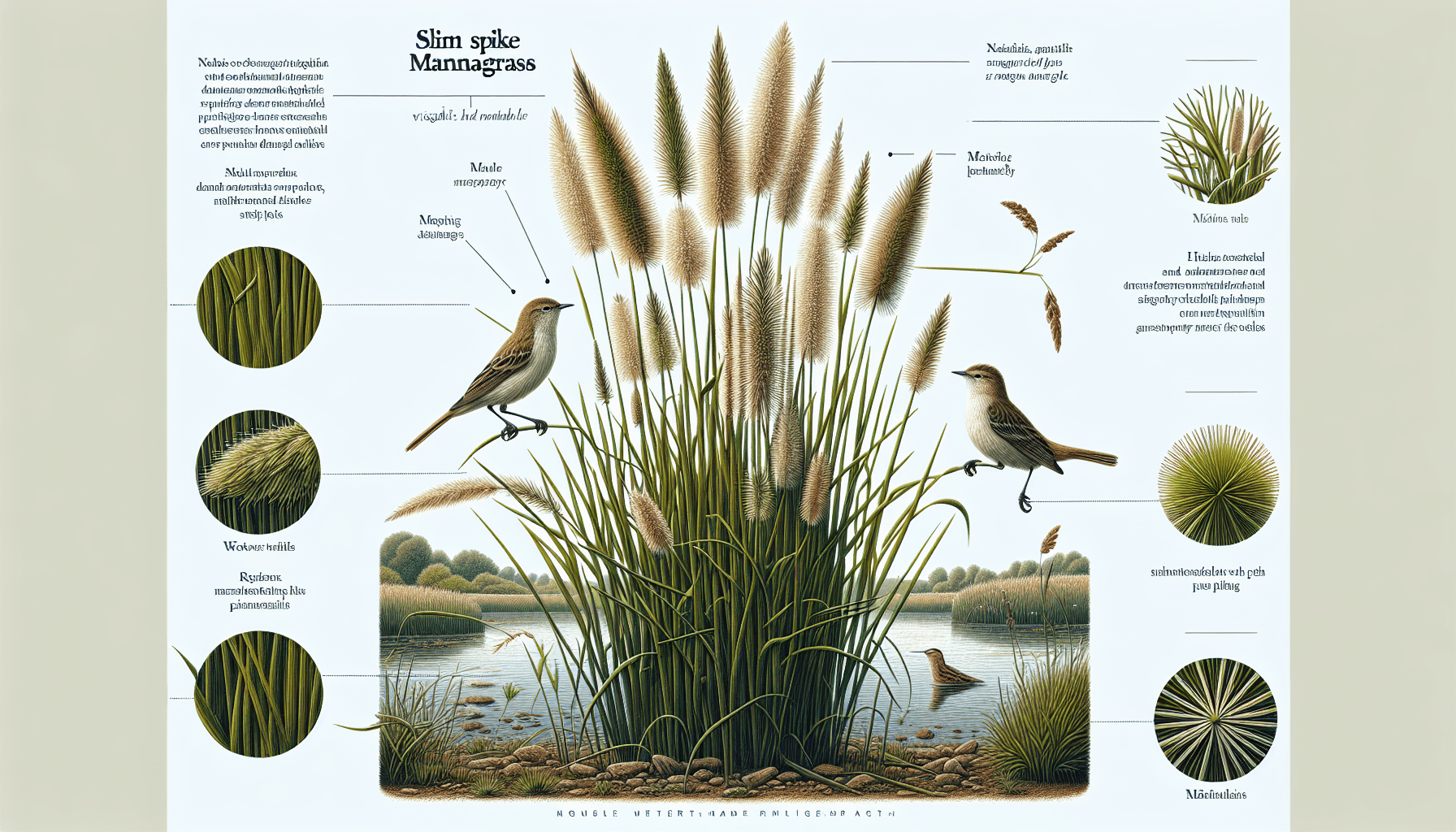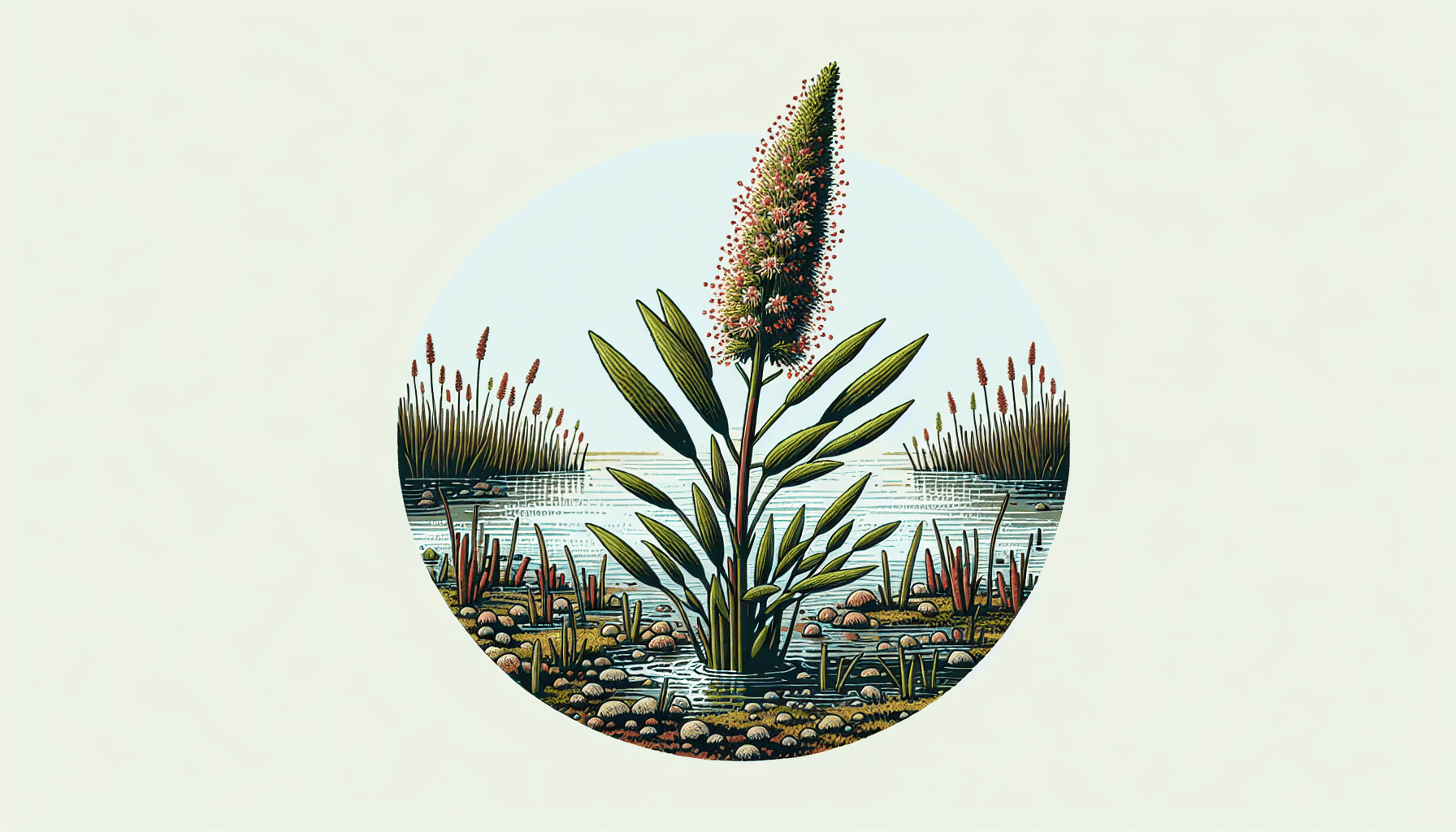As you journey through the diverse world of aquatic flora, a particular species catches your attention, namely — the Slim Spike Mannagrass. Originating from a large grass family, Poaceae, this unique water plant takes its stand proudly among its subfamily, the Pooideae. Known scientifically as “Glyceria declinata,” this short perennial grass displays its distinction through its preference for watery habitats, making it an intriguing player in the world of hydrophytic adaptation and aquatic ecosystems. The subsequent discourse will explore various aspects of Slim Spike Mannagrass, detailing its structural morphology, the critical role it plays in its ecological environment, and the significant benefits it offers to the world of aquatic natural resource management. Get prepared to uncover the nuances of this fascinating aquatic grass and to understand it beyond its benign botanical exterior.

Description of Slim Spike Mannagrass
Slim Spike Mannagrass, scientifically known as Glyceria declinata, is a lesser-known yet important aquatic flora species. Its identification rests mainly on its physical characteristics and distinct habitat.
Physical Characteristics
A distinguishing attribute of Slim Spike Mannagrass is its slender and lengthy form, with narrow leaves that drape downwards. The plant’s height mostly lies between 30 to 90 cm. Its spikelets, measuring 3-5 mm, are typically around 6-flowered and lie along a centric stem in a slim-spiked pattern, from which the plant gets its name. The grass’s tenderness has an overall effect of subtle elegance and quiet strength.
Habitat Preferences
Slim Spike Mannagrass prefers aquatic to semi-aquatic habitats. It thrives exceptionally well in standing or slowly moving water bodies such as ponds, lakes, marshes, and slow streams. The nutrient-rich, muddy to sandy bottom of these water bodies provides an ideal environment for this species.
Perennial Growth Pattern
Slim Spike Mannagrass exhibits a perennial growth pattern, meaning it lives for more than two years. However, while the above-ground parts of the plant may die back in winter in colder climates, the roots survive underground, sprouting again with the advent of suitable climate conditions.
Historical Background of Slim Spike Mannagrass
Not much is known about the history of Slim Spike Mannagrass, but aspects such as its discovery, etymology and distribution tell an intriguing story.
Discovery Timeline
The timeline of this grass species’ discovery is not readily available; however, botanical texts suggest that its classification occurred during the last two centuries when the foundations of modern taxonomy were being laid.
Prevailing Etymology
The genus name “Glyceria” originates from the Greek word “glykerós,” which translates to “sweet.” This alludes to the grass’s sugary sap. Its species name “declinata” refers to the angled, curvilinear structure of its spikelets.
Distribution and Location Information
Slim Spike Mannagrass registers a broad global distribution. It is widely present across Europe, Asia, North America, and parts of Australia. Its love for moist and water-logged areas means you can commonly find it in the cooler wetland habitats of these regions.
Slim Spike Mannagrass in Aquatic Life
The presence of Slim Spike Mannagrass in aquatic ecosystems is not just decorative but indispensable.
Role in Aquatic Ecosystem
This grass species plays a significant role in stabilizing soil and preventing erosion in its aquatic habitats. Its dense foliage also acts as shades and refuge for smaller aquatic organisms, fostering biodiversity.
Interactions with Aquatic Species
As part of the aquatic fauna, Slim Spike Mannagrass frequently interacts with various species. For example, waterfowl often consume its seeds, while insects rely on its leaves for sustenance and larvae nesting.
Importance in Water Quality
This plant plays a subtle yet crucial role in maintaining water quality. By absorbing excess nutrients from the water, it discourages the excessive growth of harmful algae, thereby playing a part in sustaining the health of its aquatic ecosystem.
Propagation and Dispersal of Slim Spike Mannagrass
The spread and proliferation of Slim Spike Mannagrass occur both naturally and via human interventions.
Natural Dispersal Mechanism
Naturally, Slim Spike Mannagrass propagates itself through its seeds. After maturation, these seeds get dispersed into the water by wind or carried away by animals, further spreading the species.
Man-made Dispersal Methods
Humans have unintentionally been contributors to the dissemination of Mannagrass, often through watercraft or fishing gear that inadvertently carry plant fragments or seeds to new locations.
Factors Influencing Growth and Propagation
Mannagrass favors open and sunlit areas with abundant water, making such conditions crucial for its growth and propagation. Furthermore, nutrient-rich soil with a muddy to sandy texture facilitates optimal growth.

Threats to Slim Spike Mannagrass
Like any other flora species, Slim Spike Mannagrass faces a set of threats affecting its survival.
Environmental Threats
Climate change with its associated totalities, including increasing temperature, irregular rainfall, and heightened storm activities, pose a significant threat to the survival of this species. Additionally, competition from other species could also affect its prevalence.
Human Induced Threats
Urbanization, leading to the loss of wetland habitats, is a valiant human-induced threat to this species. Pollution of water bodies through industrial activities or farming practices can severely affect the health of these grass species.
Potential Diseases and Pests
While not much information is available about specific pests and diseases, like any other plant species, Slim Spike Mannagrass is likely susceptible to certain types of fungi and insects that can inhibit their growth and survival.
Conservation Efforts for Slim Spike Mannagrass
Despite the inherent risks, the conservation status for the Slim Spike Mannagrass is not known clearly, and efforts are writing towards its survival remain unspecified.
Status in Endangered Species List
Currently, no direct reference of Slim Spike Mannagrass exists in the endangered species list. However, as more wetlands are getting affected by human activities, there is a likelihood that this status may change in the future.
Conservation, Restoration and Management Strategies
Conversely, due to its role in aquatic ecosystems, its propagation or preservation in appropriate environments could be necessary as part of wider wetland flora restoration or management practices.
Legal Protection Status
At this time, no specific legal protection measures seem to exist for Slim Spike Mannagrass. However, general protections in place for wetlands may offer it some indirect legal cover.
Slim Spike Mannagrass and Bioenergy
Mannagrass’s role in bioenergy production is an area still in exploration.
Potential as Biofuel Source
Given its habitat and growth patterns, there is potential in investigating the application of Slim Spike Mannagrass in the production of biofuels. Its capacity for rapid growth and abundant biomass production could be put to use in this context.
Current Research on Energy Generation
While there is a little record of Mannagrass being directly used for energy generation, its role in this field may become clearer with future research. Currently, similar grass species are being explored for biofuel production, providing grounds for potential research expansion to include Mannagrass.
Possible environmental Impact
If proven viable for bioenergy production, Mannagrass could contribute positively to the environment by providing a renewable source of energy. Simultaneously, caution would be needed to avoid the potential for this plant to become invasive if cultivation for energy generation was pursued.
Slim Spike Mannagrass as Fodder
Whether Slim Spike Mannagrass serves as an appropriate fodder for animals remains unclear. Its ecological benefits, however, provide some grounds for exploration.
Usability for Grazing Animals
Many aquatic grasses serve as nutrition sources for various animals, including waterfowl and other herbivores. While information on Slim Spike Mannagrass’s specific use as fodder is scant, given its water-dwelling characteristics, it may be part of the diet for such animals.
Nutritional Value
Detailed information on the nutritional value of Slim Spike Mannagrass is currently lacking. However, the genus Glyceria is often attributed with moderate to high nutrition levels, providing some indication of potential value.
Applicability for Aquaculture
Recently, aquaculture farms have been considering aquatic plants for fish and shrimp diets, and there may be potential to explore Slim Spike Mannagrass in this context. More research towards this end would be beneficial.
Medicinal Usage of Slim Spike Mannagrass
No known medicinal uses of Slim Spike Mannagrass are recorded currently, despite the rich history of plant-based therapy.
Historic Medicinal Usage
Despite a rich tradition of plant-based remedies, no specific references hint at the historic medicinal usage of Slim Spike Mannagrass.
Current Medicinal Applications
Similarly, current literature reveals no mentions of the species as part of modern herbal remedies or alternative therapies.
Potential Future Research
The lack of past and present medicinal usage should not necessarily negate the potential for future discoveries. Given the richness of plant biodiversity in yielding unexpected medicinal benefits, Slim Spike Mannagrass may warrant future pharmacological research.
Slim Spike Mannagrass in Landscape Design
The role of Slim Spike Mannagrass in landscape design is under-utilized, with the plant providing potential aesthetic and functional contributions in certain contexts.
Suitability for Landscaping
Due to its capability to grow in wetlands and prove to be a hardy perennial, Slim Spike Mannagrass fits as part of the composition in aquatic and overlaying landscapes. It would enhance such designs through its soft, feathery appearance and bring a touch of natural beauty to areas with excess water.
Maintenance and Care Requirements
Given its natural habitat of moist to waterlogged soils, maintenance for Mannagrass would include ensuring consistent water levels and preventing the possible spread to unwanted areas.
Aesthetic Value
The Slim Spike Mannagrass, with its slender spikes and light, feathery leaves, holds a subtle aesthetic appeal. When used in landscape design, it could bring a sense of tranquillity and natural elegance, especially within water features and pond edges.